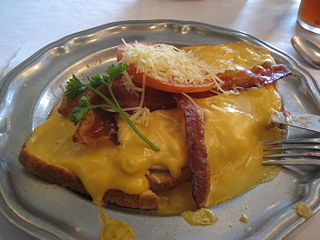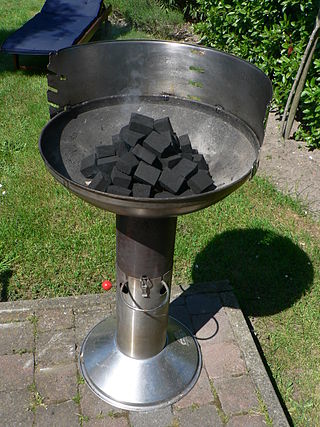
Satay, or sate in Indonesian spelling, is a Southeast Asian form of kebab made from seasoned, skewered and barbecued meat, served with a sauce.

Offal, also called variety meats, pluck or organ meats, is the internal organs of a butchered animal. The word does not refer to a particular list of edible organs, and these lists of organs vary with culture and region, but usually exclude skeletal muscle. Offal may also refer to the by-products of milled grains, such as corn or wheat.

Shashlik, or shashlyck, is a dish of skewered and grilled cubes of meat, similar to or synonymous with shish kebab. It is known traditionally by various other names in the Caucasus, Eastern Europe and Central Asia, and from the 19th century became popular as shashlik across much of the Russian Empire and nowadays in the Russian Federation and former Soviet Union republics.

Kebab, kabob, kebap, or kabab (Kashmir) is roasted meat that originates from the Middle East. Many variants of the category are popular around the world, including the skewered shish kebab or souvlaki and the doner kebab or gyros with bread.

Malay cuisine is the traditional food of the ethnic Malays of Southeast Asia, residing in modern-day Malaysia, Indonesia, Singapore, Brunei, Southern Thailand and the Philippines as well as Cocos Islands, Christmas Island, Sri Lanka and South Africa.

Pilaf, pilav or pilau is a rice dish, usually sautéed, or in some regions, a wheat dish, whose recipe usually involves cooking in stock or broth, adding spices, and other ingredients such as vegetables or meat, and employing some technique for achieving cooked grains that do not adhere to each other.

The spiedie is a food consisting of marinated meat that is often threaded onto skewers before being grilled and served on a long bread roll or sliced Italian bread. Spiedies are local to Binghamton in the central Southern Tier of New York, and somewhat more broadly known and enjoyed throughout Central New York. A spiedie consists of cubes of chicken, pork, lamb, veal, venison or beef. The meat is marinated overnight or longer, then grilled on spits over a charcoal pit.

Sosatie is a traditional South African dish of meat cooked on skewers. The term derives from sate and saus. It is of Cape Malay origin, used in Afrikaans, the primary language of the Cape Malays, and the word has gained greater circulation in South Africa. Marinated, cubed meat is skewered and cooked by braaing (barbecued) shish-kebab style. Sosatie recipes vary, but commonly the ingredients can include cubes of lamb, beef, chicken, dried apricots, red onions and mixed peppers.

The cuisine of Kentucky mostly resembles and is a part of traditional Southern cuisine. Some common dinner dishes are fried catfish and hushpuppies, fried chicken and country fried steak. These are usually served with vegetables such as green beans, greens, pinto beans slow-cooked with pork as seasoning and served with cornbread. Other popular items include fried green tomatoes, cheese grits, corn pudding, fried okra, and chicken and dumplings, which can be found across the commonwealth.

Barbecue varies by the type of meat, sauce, rub, or other flavorings used, the point in barbecuing at which they are added, the role smoke plays, the equipment and fuel used, cooking temperature, and cooking time.

Khorovats is an Armenian barbecue. The meat may be marinated before grilling, but it does not have to be. It can be made with lamb, pork, beef, chicken, fish, or even veal. This is generally a dish reserved for "festive occasions".

Many regional cuisines feature a mixed grill, a dish consisting of an assortment of grilled meats.
A collop is a slice of meat, according to one definition in the Oxford English Dictionary. In Elizabethan times, "collops" came to refer specifically to slices of bacon. Shrove Monday, also known as Collop Monday, was traditionally the last day to cook and eat meat before Ash Wednesday, which was a non-meat day in the pre-Lenten season also known as Shrovetide. A traditional breakfast dish was collops of bacon topped with a fried egg.

Afghan cuisine is influenced to a certain extent by Persian, Central Asian and Indian cuisines due to Afghanistan's close proximity and cultural ties. The cuisine is halal and mainly based on mutton, beef, poultry and fish with rice and Afghan bread. Accompanying these are common vegetables and dairy products, such as milk, yogurt, and whey, and fresh and dried fruits such as apples, apricots, grapes, bananas, oranges, plums, pomegranates, sweet melons, and raisins. The diet of most Afghans revolves around rice-based dishes, while various forms of naan are consumed with most meals. Tea is generally consumed daily in large quantities, and is a major part of hospitality. The culinary specialties reflect the nation's ethnic and geographic diversity. The national dish of Afghanistan is Kabuli palaw, a rice dish cooked with raisins, carrots, nuts, and lamb or beef.

Javanese cuisine is the cuisine of Javanese people, a major ethnic group in Indonesia, more precisely the province of Central Java, Yogyakarta and East Java.

Sundanese cuisine is the cuisine of the Sundanese people of Western Java, and Banten, Indonesia. It is one of the most popular foods in Indonesia. Sundanese food is characterised by its freshness; the famous lalab eaten with sambal and also karedok demonstrate the Sundanese fondness for fresh raw vegetables. Unlike the rich and spicy taste, infused with coconut milk and curry of Minangkabau cuisine, the Sundanese cuisine displays the simple and clear taste; ranged from savoury salty, fresh sourness, mild sweetness, to hot and spicy.

A meatball is ground meat (mince) rolled into a ball, sometimes along with other ingredients, such as bread crumbs, minced onion, eggs, butter, and seasoning. Meatballs are cooked by frying, baking, steaming, or braising in sauce. There are many types of meatballs using different types of meats and spices. The term is sometimes extended to meatless versions based on vegetables or fish; the latter are also commonly known as fish balls.

A stew is a combination of solid food ingredients that have been cooked in liquid and served in the resultant gravy. Ingredients can include any combination of vegetables and may include meat, especially tougher meats suitable for slow-cooking, such as beef, pork, venison, rabbit, lamb, poultry, sausages, and seafood. While water can be used as the stew-cooking liquid, stock is also common. A small amount of red wine or other alcohol is sometimes added for flavour. Seasonings and flavourings may also be added. Stews are typically cooked at a relatively low temperature, allowing flavours to mingle.

















